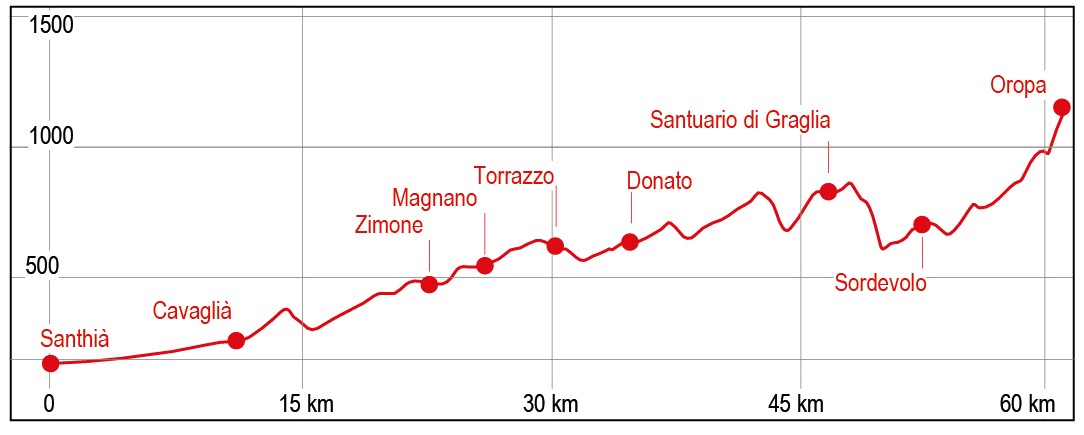THE OROPA TRAIL
Trail marker:
segnavia gialli e neri e frecce gialle dipinte dedicate al Cammino di Oropa
Place of departure:
Stazione di Santhià
Place of arrival:
Santuario di Oropa
Departure altitude:
183 m
Arrival altitude:
1180 m
Duration:
4 days
Uphill height difference:
1000 m
Type of excursion:
Trekking
Season:
Winter, Spring, Late spring/summer, Autumn
Do you dream of walking the great European routes? Put yourself to the test with the Oropa Trail! Discover the beauty of the landscape, history and culture of the Biella area: from the agricultural plain towards the Serra Morena to the Biellese Alps and the Sanctuary of Oropa.
Access and parking
Departure from the car park at Santhià station, connected to the Milan-Turin interregional railway line. Several car parks are available near the station.
Route
The trail develops in four short stages (15.1 to 17.4 km) of increasing difficulty. This "slow" formula is ideal for those who have never tackled an itinerary in stages and want to put themselves to the test, and can a "training walk", to prepare for the great European paths such as the Via Francigena or the Camino de Santiago.
These are the stages and the height differences:
Santhià-Roppolo: 16.5 km, 230 m difference in altitude;
Roppolo-Sala Biellese: 17.4 km, 400 m difference in altitude;
Sala Biellese-Sanctuary of Graglia: 16.1 km, 550 m difference in altitude;
Sanctuary of Graglia-Sanctuary of Oropa: 15.1 km, 800 m difference in altitude.
Stage 1 - Santhià-Roppolo
From Santhià the route follows the Via Francigena, the most famous and ancient Italian path, towards the hills of the Ivrea morainic amphitheatre. After passing through the village of Cavaglià, you reach Roppolo, dominated by the imposing castle, from which there is a beautiful view of Lake Viverone. The stage is easy but with little shade, so in the hot season protect yourself adequately, and take a good supply of water with you because you will find water, bars and supermarkets only in Cavaglià. In Roppolo, you can spend the night at the Casa Del Movimento Lento (House of the Slow Movement), run by Alberto Conte, the designer of the Trail of Oropa, who will be able to give you useful advice and directions for continuing your trail.
Stage 2 - Roppolo-Sala Biellese
The second stage runs through the wooded hills of the Serra d'Ivrea, Europe's largest moraine amphitheatre. The first stop is at the Ricetto di Viverone, the ancient fortified village from which there is a beautiful view of the morainic amphitheatre of Ivrea and Lake Viverone. After climbing up to the village of Zimone, visit the Monastery of Bose, seat of the community founded by Enzo Bianchi, the ancient village of Magnano, with another well-preserved Ricetto, and from here along paths hidden in the woods reach Torrazzo. Once in front of the church, take the tarmac road to Sala Biellese and shortly afterwards turn right onto a tarmac road that continues along a path. Descend into a small valley and climb up the other side to the Sanctuary of the Holy Assumption. Here, turn right onto the tarmac road to reach Future is Nature campsite and, further on, the IL Raglio B&B. In the hot season, there may be many mosquitoes on this stage in the woods, so we recommend that you take a repellent with you.
Stage 3 - Sala Biellese-Sanctuary of Graglia
From the campsite or B&B, take the tarmac road towards the centre of Sala Biellese, turn left at the parish church to reach the provincial road for Torrazzo, which you leave immediately to take a path on the right that enters the forest and after a few kilometres reaches the beautiful Cossavella Lake.
From here, you leave the Serra Morena to reach Donato, where you can take refreshments, stock up on water and do some shopping, before tackling a series of rather challenging climbs and descents that lead to the Sanctuary of Graglia, on the slopes of Mombarone, the watershed between Piedmont and the Aosta Valley.
Stage 4 - Sanctuary of Graglia-Sanctuary of Oropa
The route runs along the side of the Mombarone and descends on a steep mule track until it crosses the Elvo River, before climbing back up towards the lovely old town of Sordevolo. From here, tackle a rather demanding up and down route, through woods and pastures with beautiful views over the Po valley, as far as Favaro. From here, we take the demanding D1 trail, which climbs towards the final destination of the trail, the scenic Oropa Sanctuary, nestled in the mountains in a small valley of the Biellese Alps.
ATTENTION: In case of heavy rain, the fords of the D1 trail can be challenging, in this case, we suggest taking the Tramvia variant. In the second part of the stage, this route offers a less demanding itinerary, which climbs from Favaro to Oropa along the former tramway track. The Tramvia variant is recommended for those who are less fit. There are frequent water fountains, bars and refreshments in Sordevolo and Favaro.
From Oropa it is possible to return comfortably to the Biella railway station by coach and from there by train back to Santhià station.
References
Il Cammino di Oropa - tre itinerari suggestivi per tutti - Alberto Conte

